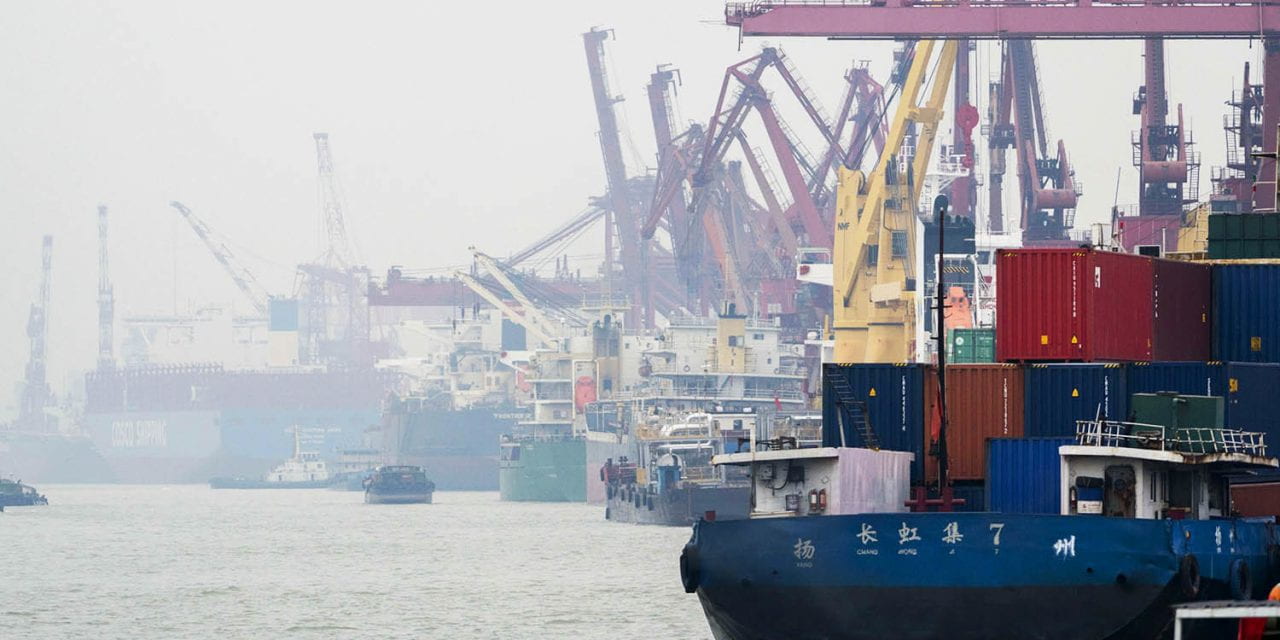China’s thrust into the global stage has allowed for a mesmerizing level of economic growth over recent decades. This growth, founded on Chinese integration into the international economy, has permitted China to begin exporting its industrial capacity as a means of achieving greater international influence. Chinese ambitions to elevate its status and influence as a world power through economic means have proven to be a headache for the dominant Western framework. This Western status-quo is led primarily by the US, and supported by IGOs such as the World Bank and the IMF. There are numerous contemporary, large scale economic foreign policy projects that have extended Chinese influence throughout the Asian continent into Europe. There is also dialogue concerning whether China can sustain its remarkable economic growth and what it would mean for the existing international economic leadership, which has to contend with China’s rise. Basic economic models of output would indicate that China still has notable room for growth, and subsequently for more large-scale international projects. Whether China poses a serious threat of displacing the Western economic framework remains hotly contested. It would be a mistake, however, to assume that China’s rise is waning and transient.
In 2013, China first announced its Belt and Road Initiative (BRI), which would allow for greater movement of capital across the Asian continent, through Europe and into North and East Africa. The maritime aspect of the project would establish sea routes through the South China Sea and across the Indian Ocean. [1] The projected total investment for the BRI would amount to $1.4 trillion, making it twelve times today’s equivalent value of the Marshall Plan following World War Two. [2] The benefits of the BRI are not isolated to the greater economic integration for which it allows. The BRI is also a means to enhance China’s role as a global power and achieve Xi Jinping’s long term vision of becoming the dominant power in Asia. [3] Programs under the BRI have effectively began extending Chinese economic influence into the Southern and Eastern portions of Europe
In 2016, under the BRI, Chinese firms constructed a thermal power plant in Bosnia which allowed the nation to transition to an export-oriented economy in European markets. Chinese firms are also constructing a photovoltaic power plant in Hungary that would produce 130 million kilowatt-hours of power, and Hungary agreed to purchase enough doses of the Chinese COVID vaccine to vaccinate 2.5 million people. The BRI has also allowed for the construction of a 2.4 kilometer cable bridge connecting the Croatian mainland to its Peljesac Peninsula. [4] In 2020, the value of China’s imports and exports along the BRI route amounted to just under $1.5 trillion. Chinese cooperation with states along the BRI extends past infrastructural projects into artificial intelligence, smart manufacturing and data collection. [5]
The various investment projects that entail the BRI are in part financed by the Asian Infrastructural Investment Bank (AIIB). The AIIB is an international investment bank primarily led by China since its creation in 2015. The AIIB currently has 100 members, and is considered a rival to the World Bank. The flow of capital and investment through AIIB institutions make the organization a primary financing mechanism for the BRI. [6] Around $22 billion in investment funds for 108 projects were supported through the AIIB by the end of 2020, with one example being a $180 million loan to Sri Lanka for COVID crisis recovery, including small and medium business support. [7] In the same year that the AIIB was founded, the Regional Comprehensive Economic Partnership (RCEP) was signed by its fifteen member states that constitute a combined population of 2.2 billion people. Notable member states include China, Australia, Indonesia, Japan, South Korea, Singapore, but not, surprisingly, the United States. [8] The RCEP’s member states make up 30% of global GDP. The partnership reduces tariffs on 92% of trade between member states, requiring 65% of service sectors to eliminate ceilings on foreign shareholding limitations. These trade liberalization measures will be conducive to larger levels of Chinese investment, thereby making this geoeconomic region more dependent on China. The RCEP also facilitates the internationalization of the Chinese Yuan and mitigates China’s dependency on the US and Europe through granting greater access to other markets. [9]
The BRI, AIIB, and RCEP are all symptomatic of China’s substantial economic growth in the 21st century intertwining with its ambitions to achieve world power status. China emerged into international markets when it joined the WTO in 2003, stoking hopes among the West that China would adopt Western norms of liberalism and free trade. This was not the case however, since the CCP maintained its autocratic legitimacy in its ability to create a prosperous economy for its populace and raise China into the status of a world power. Since joining the WTO, China has enjoyed consistent annual growth rates of 18% in international trade and almost 10% in GDP. Integrating the Chinese economy into the international markets allowed China to utilize its massive economic capacity, notably as the rapid urbanization of its near-billion working-aged population has provided an enormous labor force to take advantage of China’s manufacturing comparative advantage. The internationalization of Chinese markets actuated substantial inflows of foreign capital, sophisticated management practices, and Western technology, all of which bolstered the efficiency and productivity of the Chinese economy. [10]
China’s success in taking advantage of its comparative advantage has allowed for a shift in focus from export-oriented growth to outward investment. This shift was accelerated after the 2008 financial crisis that limited the West’s ability to absorb Chinese exports, creating the need for economic integration with other global markets. [11] This outward shift has granted it the influence and capacity necessary to further its long-term geopolitical goals. These primarily include reemerging as a major regional power in the greater Asian sphere and receiving the respect and influence entitled to a world power. [12] The BRI serves to do just this through facilitating enhanced connectivity between China and the Asian and European economies. The RCEP furthers this regional integration, which bolsters China’s economic influence within its sphere of interest. The AIIB, formed out of China’s frustration with the unsatisfactory pace of reforms of Western institutions such as the IMF and the World Bank, rivals existing development banks and helps to consolidate international economic influence into Chinese hands. [13]
Though China’s growth, and the shift in power and influence that entails, is a thorn in the side of the West, many wonder whether this growth is sustainable and the implications that it would have for the West. This is dependent on China’s economic capacity, which can be broadly explained by the Solow model for GDP output. This model contends that output is a product of capital, labor, and the innovation or technology of the population. As an economy becomes more efficient and sophisticated, there is less room for substantial growth since modern technological upgrades have already been implemented, and the economy has structurally adapted to operate at high rates of productivity. Growth will, therefore, plateau and stagnate over time. [14] This explains why the US, with a GDP per capita of over $62,500, had a GDP growth rate of 2.16% in 2019. [15] China’s growth rate in 2019 was over 6% with a GDP per capita of only $16,100. [16] After all, China has a labor force of 775 million people compared to the American labor force of 146 million people. [17] Should Chinese workers reach only half of the productivity level of American workers, China’s economy would be double that of the United States. [18]
To experience this growth, China needs capital and innovation. China is the world’s largest exporter and runner up for the top global importer. Industry constitutes forty percent of its economy, and its industrial growth rate is roughly 6%, double that of the US. [19] These statistics indicate a substantial inflow of foreign capital from abroad. Concerning innovation, China is home to the world’s best university for engineering, graduates four times as many university STEM students as the United States, and filed for twice as many patents as the United States. China’s innovation is visible in its shift toward high-tech manufacturing, and is the world’s leading producer in computers, communication systems and pharmaceuticals. [20] China’s lower GDP per capita indicates that large segments of the population still have room for sophistication and advancement. China’s economy, therefore, retains the capacity for continued levels of growth to a degree that warrants attention from Western international economic leadership. This is because, given the integrated nature of the Chinese economy with global markets, Chinese growth will coincide with greater international economic ambitions with which the West must contend.
China’s foreign economic policy is rooted in competition with the existing, dominant Western economic framework. The sustained economic growth that China has enjoyed in recent decades has granted it the capacity necessary to project its economic influence abroad, bolstering China’s standing as a global power. The Chinese economy still has substantial potential for future growth based on metrics including population, innovation, and capital. Given the intertwined nature of China’s economic growth and its economic ambitions abroad, China can therefore be expected to remain a chief threat to Western economic power dominance throughout Asia and parts of Europe into the foreseeable future. Whether China will triumph in this competition is up for serious debate; in fact, there is convincing evidence to the contrary. The West must recognize, however, that China is not close to achieving its full potential, and that geoeconomic competition is here to stay.
1- Bradford Betz, “What Is China’s Belt and Road Initiative?,” Fox News (Fox News, May 1, 2020), https://www.foxnews.com/world/what-is-chinas- belt-road-initiative.
2 Zhiqun Zhu, “China’s AIIB and OBOR: Ambitions and Challenges,” The Diplomat (The Diplomat, October 9, 2015), https://thediplomat.com/2015/10/ chinas-aiib-and-obor-ambitions-and-challenges/.
3 Graham T. Allison, Destined for War: Can America and China Escape Thucydides’s Trap? (Boston: Mariner Books/Houghton Mifflin Harcourt, 2018). p. 109
4 Gao Lei, “China-CEEC Cooperation Becomes Role Model under BRI,” Khmer Times (Khmer Times, February 15, 2021), https:// www.khmertimeskh.com/50814235/china-ceec-cooperation-becomes-role-model-under-bri/.
5 “BRI: A Review of Global Progress in 2020,” Life of Guangzhou (Life of Guangzhou, February 20, 2021), https://www.lifeofguangzhou.com/knowGZ/ content.do?contextId=13129&frontParentCatalogId=175.
6 Jonathan Barrett and Praveen Menon, “Pacific Island Nations Turn to Beijing-Backed AIIB as Pandemic Sinks Economies,” Reuters (Reuters, January 25, 2021), https://www.reuters.com/article/us-china-pacific-cookislands-idUSKBN29U00A.
7 Xinhua, “Five Years of AIIB: How China-Initiated Development Bank Helps Transform Lives across Asia,” Khmer Times (Khmer Times, January 30, 2021), https://www.khmertimeskh.com/50808786/five-years-of-aiib-how-china-initiated-development-bank-helps-transform-lives-across-asia/. ; “AIIB Approves USD 180 Mn Loan to Sri Lanka,” Daily Mirror (Daily Mirror, February 26, 2021), http://www.dailymirror.lk/breaking_news/AIIB- approves-USD-180-mn-loan-to-Sri-Lanka/108-206670.
8 “RCEP: APAC Mega-Pact Signed and Ready to Deliver,” Financier Worldwide (Financier Worldwide), accessed February 28, 2021, https:// www.financierworldwide.com/rcep-apac-mega-pact-signed-and-ready-to-deliver.
9 Wendy Wang, “RCEP: A Major Driver to Boost the Chinese and Regional Economy EJINSIGHT,” Ejinsight (Ejinsight, February 17, 2021), https:// www.ejinsight.com/eji/article/id/2713780/20210217-RCEP:-A-major-driver-to-boost-the-Chinese-and-regional-economy.
10 Reuben Tang, “Chinese Economic Policy in the 21st Century: Growth, Imbalance, and Considerations for Australia,” Inquiries Journal (Inquiries Journal, August 1, 2013), http://www.inquiriesjournal.com/articles/748/chinese-economic-policy-in-the-21st-century-growth-imbalance-and- considerations-for-australia.
11 Zhu, “China’s AIIB and OBOR: Ambitions and Challenges,”
12 Allison, Destined for War. p. 109
13 Zhu, “China’s AIIB and OBOR: Ambitions and Challenges,”
14 “China: Global Trade and Comparative Advantage,” Illustrated Curiosity (Illustrated Curiosity, September 28, 2017), https:// www.illustratedcuriosity.com/economics/trade-china-and-comparative-advantage/.
15 “The World Factbook- United States,” Central Intelligence Agency (Central Intelligence Agency), accessed February 28, 2021, https://www.cia.gov/ the-world-factbook/countries/united-states/
16 “The World Factbook- China,” Central Intelligence Agency (Central Intelligence Agency), accessed February 28, 2021, https://www.cia.gov/the- world-factbook/countries/china/.
17 The World Factbook- United States,” Central Intelligence Agency ; “The World Factbook- China,” Central Intelligence Agency
18 Allison, Destined for War. p. 7
19 “The World Factbook- China,” Central Intelligence Agency
20 Allison, Destined for War. p. 16-17







